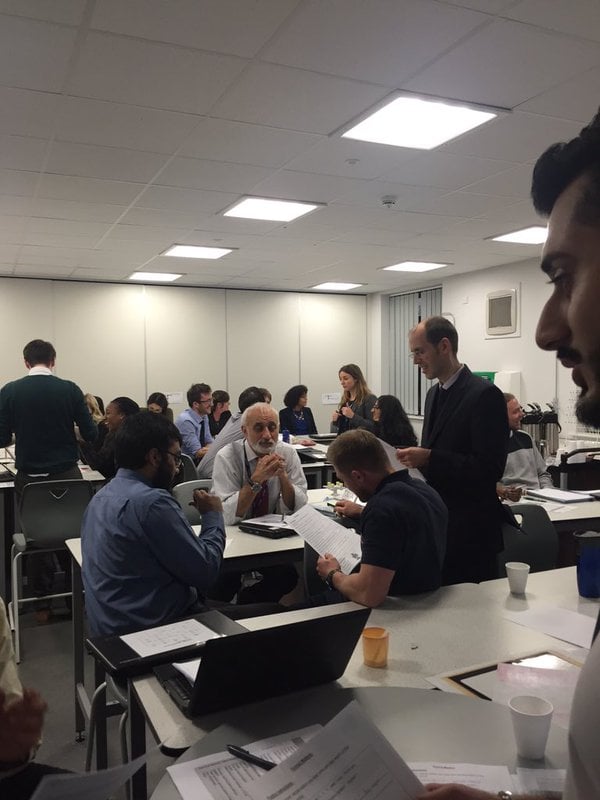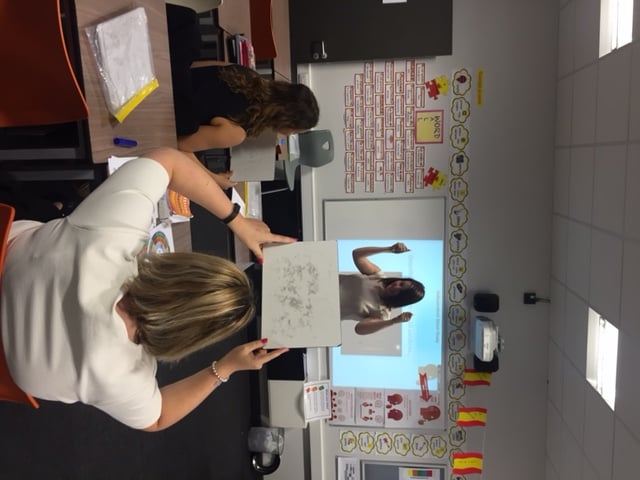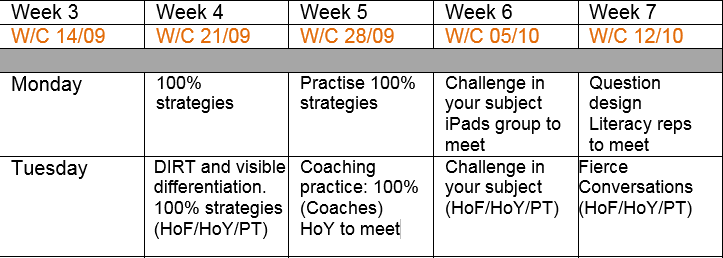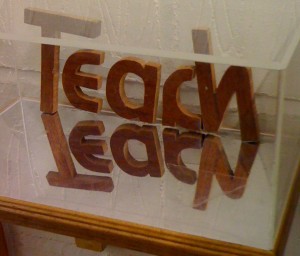Practice plays a huge part in teacher development in our school and this week I was reminded of just how effective it can be. Doug Lemov, in Practice Perfect, writes that “Great practice…is not merely a triumph of design and engineering, but a triumph of culture.” Here I share five examples from the last week which exemplify how powerful a culture of practice can be.
Practising our questioning
We want our CPD to have a lasting impact, so we will often organise a practice session to follow on from a more theoretical session the previous week. Last week we had Principal Teachers from various subjects delivering questioning training as part of a carousel for staff. Following this, we asked teachers which strategies they would like to practise. This meant that we focussed on wait time and stretching students with follow-up questions.
 My colleague Simon has put a great deal of effort into designing and refining a model of practice which works. We always start with a good model, so in this instance I used Teach Like a Champion videos to show narrated and silent wait time and effective deeper questioning. Before practising, I asked staff to script possible questions/ phrases they might use and to reflect on how they would ensure wait time was effective. Because practice is so common in our CPD sessions, we don’t need to spend too much time explaining what everyone has to do. Everyone practises; everyone feeds back. The only problem this week-if this can even be considered a problem-was that some groups became far too interested in discussing questioning strategies that they didn’t all get to practise. I saw many of the strategies used in lessons later in the week and I am sure that I’ll continue to see them over time.
My colleague Simon has put a great deal of effort into designing and refining a model of practice which works. We always start with a good model, so in this instance I used Teach Like a Champion videos to show narrated and silent wait time and effective deeper questioning. Before practising, I asked staff to script possible questions/ phrases they might use and to reflect on how they would ensure wait time was effective. Because practice is so common in our CPD sessions, we don’t need to spend too much time explaining what everyone has to do. Everyone practises; everyone feeds back. The only problem this week-if this can even be considered a problem-was that some groups became far too interested in discussing questioning strategies that they didn’t all get to practise. I saw many of the strategies used in lessons later in the week and I am sure that I’ll continue to see them over time.
Practising our coaching
On Tuesday Simon led a session on giving coaching feedback with our Heads of Faculty and Principal Teachers. We have a whole half term dedicated to ensuring that our coaching is high quality and consistent, which gives us the luxury of spending time practising. (Coaching involves weekly low-stakes observations and short feedback meetings.) We practised how we might ‘tease out’ a coaching target from a coachee, ensuring they retained ownership of it, and also the key idea of linking praise to concrete examples. I obviously buy in to these practice sessions, but the culture feels so embedded that all leaders participate fully and this can only be a good thing. Practising coaching doesn’t just help us to coach others; it can help us to become better at coaching ourselves.
Practising our meetings
As this session was going on, Heads of Year were in the room on the opposite side of the corridor, practising for the meetings they would each be having with form tutors the following day. There are some important changes happening to tutor time and they wanted to be clear and consistent in the message. I am a year eleven form tutor and on Wednesday I was in the year team meeting where the impact of the practice was obvious. The presentation was clear and every part of it made sense. For me, the presentation was excellent, not only because of the content (sensible changes that removed any unnecessary admin and focused on the core roles of form tutors) but because of the way the explanation was delivered by Nick, the HoY. Talking to another Head of Year, he felt that this practice session had been incredibly useful and that we should arrange more of them. Which we will.
Practising our routines
This week a new senior leader joined us and was immediately given a practice session on school routines, along with a cover supervisor. Practice can be difficult and uncomfortable for some, so there is often a sense that we might have to sell it. But the best way to get ‘buy in’ is often just to practise and then the benefits are tangible. Not only do these introductory sessions mean that certain school routines are embedded quickly, but an appreciation of practice can happen too. I believe that practising classroom routines on the first day back was such a fundamental part of establishing the positive school atmosphere that we have at Dixons Kings. Far more useful than a school policy document, far more hands on than a powerpoint, practice works.
Practising in coaching
In our weekly coaching feedback meetings, there is often a chance to practise. This won’t necessarily always happen, but the opportunity can be taken. This is certainly the area where practice is not yet fully embedded, and we have a CPD session on Tuesday with coaches looking at this. As a coach, I have found that practice and rehearsal works well with all teachers, whatever their level of expertise and experience. I work with some excellent teachers and with them practice means that we can have a very precise focus and get it right. For example, one great teacher I have been working with has been focussing on her tone of voice during errors, experimenting to avoid a tone of disapproval while indicating that we must be fastidious in avoiding errors. Practice is great for this kind of thing.
On Tuesday we will be practising practising. I know that today Simon will be rehearsing his session, which means that he will be practising practising practising. And you don’t get more committed than that!
See also these two posts on practising in subject teams:
Practice: a collaborative approach to successfully tackling curriculum changes (written by my head of department)


